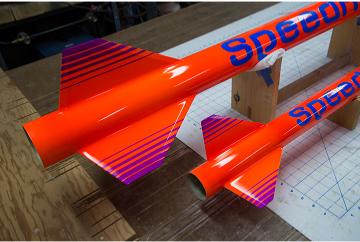SpeedRunner 75 10/17/15 Flight Data Analysis
Copyright © Thomas Fetter
2014-2025
For this first flight, SpeedRunner 75 flew on a two grain Aerotech K560W. SpeedRunner is designed to hold up to a 6 grain (36.3") M1850W motor casing.
SpeedRunner 75 is a 3 inch minimum diameter, 89 inch long rocket, Made from Performance Rocketry fiberglass tubes and nosecone, and weighing 9 lbs without the motor. It uses two PerfectFlite StatoLoggers for dual/dual deployment mounted in the altimeter bay in the middle of the rocket. A Beeline GPS and the RAF Datalogger were housed in the nosecone, wrapped in bubble wrap.
This was the first flight of SpeedRunner 75. It was flown at the 2015 October Sky launch sponsored by Tripoli Central and held at the Maddox Dairy in Helm, California.
SpeedRunner 75 on its way to 10,800 feet.

Here is a link to the SpeedRunner 75 flight visualization video. (See the Flight Visualization page for more details on the Python visualization program). Click the picture at the left to enlarge a snapshot of the completed visualization.
The 3-axis rotational rate data and the z-axis acceleration data are from the RAF Data Logger. The Altitude data is the PerfectFlite StratoLogger, and the location data is from the Beeline GPS.
From the Ground Frame Rotation Angle, the rocket makes an initial turn of about 15 degrees that slowly increases during the flight. Being a long rocket, it has almost 5 calipers of distance between the CG and CP with a smaller K motor, so is very sensitive to the lateral force of a cross-wind until it picks up velocity.
Unlike the Arliss flight, Speedmotion's spin is not due to canted fins. This can be seen from the Rocket Spin Rate graph. If the spin were due to the fins being angled, then the spin rate would increase and decrease in direct proportion to the rockets's velocity. Speedmotion spins at a fixed rate of approximately -0.5 revolutions per second (rps) for the first 16 seconds of the flight, and then reverses and spins at a rate of 1 rps, which decreases until the ejection charge fires at 26 seconds into the flight. A very brief reverse in rotation occurs at motor burn-out at 4 seconds into the flight. My best guess is the rocket's slow spin is caused by a thrust imbalance in the motor. The K560W uses a multi-throat (medusa) nozzle. The multiple smaller orifices are probably more susceptible to being clogged by combustion debris that can cause a slight thrust imbalance. The rapid reversal at motor burn-out indicates this as a likely cause.
A soft landing a half mile from the launch pad to finish a successful first flight.
Here is the Beeline GPS generated .kml file, opened in Google Earth, showing the complete profile of the flight.
Here is a link to the Execl Flight Data Analysis spreadsheet with the StratoLogger, Beeline GPS, and RockSim simulation data for this flight of SpeedRunner 75. The Google Earth plot is visually interesting, but the graphs in the spreadsheet have more analytic detail.
For more information on the spreadsheet, see my Sport Rocketry article posted on the Flight Data Analysis page.
The last three tabs of the spreadsheet have the raw data that is used by the Python Visualization program used to create the video below.
One of the most surprising observations in looking at the RAF DataLogger acceleration data is shown on the graph at the left. The graph shows the x-axis (lateral, or sideways) acceleration during the first half second of the flight. For the first 0.15 seconds, the rocket is going up the launch rail. While on the launch rail, the rocket experiences vibrations in excess of ±1 gee, much greater than the level of vibration after the rocket leaves the rail.
Click on graph to enlarge.













